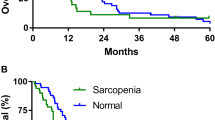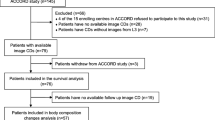Abstract
Purpose
The purpose of this study was to elucidate the effect of decreased muscle mass on the toxicity and survival of patients with colon cancer treated with adjuvant chemotherapy after surgery.
Methods
We reviewed the data of 229 consecutive patients with stage III colon cancer who received adjuvant oxaliplatin, 5-fluorouracil, and leucovorin chemotherapy at a single center between 2003 and 2010. Baseline muscle mass was assessed by measuring the cross-sectional area of the psoas muscle at the level of the fourth lumbar vertebra on computed tomography images. Effects of muscle mass on toxicity of chemotherapy and survival were assessed.
Results
The median age of the 229 patients was 61 years (range, 28–80) and 134 (58.5 %) were men. The mean psoas muscle mass index (PI, psoas muscle area divided by height2 [mm2/m2]) was 548.3. A 1 SD decrement in the PI was associated with an increase in all grade 3–4 toxicities in univariate (OR = 1.69, 95 % CI = 1.18–2.27) and multivariate (OR = 1.56, 95 % CI = 1.05–2.38) analyses. In univariate analysis, the PI was not associated with overall survival. However, multivariate analysis showed that a 1 SD decrement in the PI increased the hazard of overall mortality by 85 % (HR = 1.85, 95 % CI = 1.10–3.13). This effect of the PI on mortality was maintained in subgroup analyses, especially in older and obese patients.
Conclusions
Decreased muscle mass was associated with increased risk of grade 3–4 toxicity and poor prognosis in patients with stage III colon cancer.




Similar content being viewed by others
References
Jemal A, Center MM, DeSantis C, Ward EM (2010) Global patterns of cancer incidence and mortality rates and trends. Cancer Epidemiol Biomark Prev 19(8):1893–1907. doi:10.1158/1055-9965.epi-10-0437
Kim Y, Jun JK, Choi KS, Lee HY, Park EC (2011) Overview of the National Cancer screening programme and the cancer screening status in Korea. Asian Pac J Cancer Prev : APJCP 12(3):725–730
Cesari M, Leeuwenburgh C, Lauretani F, Onder G, Bandinelli S, Maraldi C, Guralnik JM, Pahor M, Ferrucci L (2006) Frailty syndrome and skeletal muscle: results from the Invecchiare in Chianti study. Am J Clin nutri 83(5):1142–1148
Clegg A, Young J, Iliffe S, Rikkert MO, Rockwood K (2013) Frailty in elderly people. Lancet 381(9868):752–762. doi:10.1016/S0140-6736(12)62167-9
Jung HW, Kim SW, Ahn S, Lim JY, Han JW, Kim TH, Kim KW, Kim KI, Kim CH (2014) Prevalence and outcomes of frailty in Korean elderly population: comparisons of a multidimensional frailty index with two phenotype models. PLoS One 9(2):e87958. doi:10.1371/journal.pone.0087958
Kim SW, Han HS, Jung HW, Kim KI, Hwang DW, Kang SB, Kim CH (2014) Multidimensional frailty score for the prediction of postoperative mortality risk. JAMA surg 149(7):633–640. doi:10.1001/jamasurg.2014.241
Fried LP, Tangen CM, Walston J, Newman AB, Hirsch C, Gottdiener J, Seeman T, Tracy R, Kop WJ, Burke G, McBurnie MA (2001) Frailty in older adults: evidence for a phenotype. J Gerontol A: Biol Med Sci 56(3):M146–156
Cruz-Jentoft AJ, Landi F, Topinkova E, Michel JP (2010) Understanding sarcopenia as a geriatric syndrome. Curr opin clin nutri metabol care 13(1):1–7. doi:10.1097/MCO.0b013e328333c1c1
Schaap LA, Pluijm SM, Deeg DJ, Visser M (2006) Inflammatory markers and loss of muscle mass (sarcopenia) and strength. Am J Med 119(6):526 e529–517. doi:10.1016/j.amjmed.2005.10.049
Schaap LA, Pluijm SM, Deeg DJ, Harris TB, Kritchevsky SB, Newman AB, Colbert LH, Pahor M, Rubin SM, Tylavsky FA, Visser M (2009) Higher inflammatory marker levels in older persons: associations with 5-year change in muscle mass and muscle strength. J Gerontol A: Biol Med Sci 64(11):1183–1189. doi:10.1093/gerona/glp097
Landi F, Liperoti R, Russo A, Giovannini S, Tosato M, Capoluongo E, Bernabei R, Onder G (2012) Sarcopenia as a risk factor for falls in elderly individuals: results from the ilSIRENTE study. Clin Nutr 31(5):652–658. doi:10.1016/j.clnu.2012.02.007
Abellan van Kan G (2009) Epidemiology and consequences of sarcopenia. J Nutri, Health & Aging 13(8):708–712
Janssen I (2006) Influence of sarcopenia on the development of physical disability: the Cardiovascular Health Study. J Am Geriatr Soc 54(1):56–62. doi:10.1111/j.1532-5415.2005.00540.x
Jung HW, Kim SW, Chin HJ, Kim KI, Kim CH (2013) Skeletal muscle mass as a predictor of mortality in the elderly population. J Kor Med Assoc 85(2):167–173
Hasselager R, Gogenur I (2014) Core muscle size assessed by perioperative abdominal CT scan is related to mortality, postoperative complications, and hospitalization after major abdominal surgery: a systematic review. Langenbecks Archives surg 399(3):287–295. doi:10.1007/s00423-014-1174-x
Lee JS, He K, Harbaugh CM, Schaubel DE, Sonnenday CJ, Wang SC, Englesbe MJ, Eliason JL (2011) Frailty, core muscle size, and mortality in patients undergoing open abdominal aortic aneurysm repair. J Vasc Surg 53(4):912–917. doi:10.1016/j.jvs.2010.10.111
Sheetz KH, Zhao L, Holcombe SA, Wang SC, Reddy RM, Lin J, Orringer MB, Chang AC (2013) Decreased core muscle size is associated with worse patient survival following esophagectomy for cancer. Dis Esophagus 26(7):716–722. doi:10.1111/dote.12020
Englesbe MJ, Patel SP, He K, Lynch RJ, Schaubel DE, Harbaugh C, Holcombe SA, Wang SC, Segev DL, Sonnenday CJ (2010) Sarcopenia and mortality after liver transplantation. J Am Coll Surg 211(2):271–278. doi:10.1016/j.jamcollsurg.2010.03.039
Prado CM, Baracos VE, McCargar LJ, Reiman T, Mourtzakis M, Tonkin K, Mackey JR, Koski S, Pituskin E, Sawyer MB (2009) Sarcopenia as a determinant of chemotherapy toxicity and time to tumor progression in metastatic breast cancer patients receiving capecitabine treatment. Clin Cancer Res 15(8):2920–2926. doi:10.1158/1078-0432.CCR-08-2242
Dodson RM, Firoozmand A, Hyder O, Tacher V, Cosgrove DP, Bhagat N, Herman JM, Wolfgang CL, Geschwind JF, Kamel IR, Pawlik TM (2013) Impact of sarcopenia on outcomes following intra-arterial therapy of hepatic malignancies. J Gastrointest Surg 17(12):2123–2132. doi:10.1007/s11605-013-2348-5
Sinicrope FA, Foster NR, Sargent DJ, O’Connell MJ, Rankin C (2010) Obesity is an independent prognostic variable in colon cancer survivors. Clin Cancer Res 16(6):1884–1893. doi:10.1158/1078-0432.CCR-09-2636
Greene FL, American Joint Committee on Cancer, American Cancer Society (2002) AJCC cancer staging manual, 6th edn. Springer, New York
Kim JY, Kim YJ, Lee KW, Lee JS, Kim DW, Kang SB, Lee HS, Jang NY, Kim JS, Kim JH (2013) Practical outcome of adjuvant FOLFOX4 chemotherapy in elderly patients with stage III colon cancer: single-center study in Korea. Jpn J Clin Oncol 43(2):132–138. doi:10.1093/jjco/hys195
Hoshikawa Y, Iida T, Ii N, Muramatsu M, Nakajima Y, Chumank K, Kanehisa H (2012) Cross-sectional area of psoas major muscle and hip flexion strength in youth soccer players. Eur J Appl Physiol 112(10):3487–3494. doi:10.1007/s00421-012-2335-7
Han SS, Kim KW, Kim KI, Na KY, Chae DW, Kim S, Chin HJ (2010) Lean mass index: a better predictor of mortality than body mass index in elderly Asians. J Am Geriatr Soc 58(2):312–317. doi:10.1111/j.1532-5415.2009.02672.x
Ribic CM, Sargent DJ, Moore MJ, Thibodeau SN, French AJ, Goldberg RM, Hamilton SR, Laurent-Puig P, Gryfe R, Shepherd LE, Tu D, Redston M, Gallinger S (2003) Tumor microsatellite-instability status as a predictor of benefit from fluorouracil-based adjuvant chemotherapy for colon cancer. N Engl J Med 349(3):247–257. doi:10.1056/NEJMoa022289
Compton CC, Fielding LP, Burgart LJ, Conley B, Cooper HS, Hamilton SR, Hammond ME, Henson DE, Hutter RV, Nagle RB, Nielsen ML, Sargent DJ, Taylor CR, Welton M, Willett C (2000) Prognostic factors in colorectal cancer. College of American Pathologists Consensus Statement 1999. Archives pathol lab med 124(7):979–994. doi:10.1043/0003-9985(2000)124<0979:PFICC>2.0.CO;2
Oken MM, Creech RH, Tormey DC, Horton J, Davis TE, McFadden ET, Carbone PP (1982) Toxicity and response criteria of the Eastern Cooperative Oncology Group. Am J Clin Oncol 5(6):649–655
Charlson ME, Pompei P, Ales KL, MacKenzie CR (1987) A new method of classifying prognostic comorbidity in longitudinal studies: development and validation. J chron dis 40(5):373–383
Hryniuk WM, Figueredo A, Goodyear M (1987) Applications of dose intensity to problems in chemotherapy of breast and colorectal cancer. Semin Oncol 14(4 Suppl 4):3–11
Andre T, Boni C, Mounedji-Boudiaf L, Navarro M, Tabernero J, Hickish T, Topham C, Zaninelli M, Clingan P, Bridgewater J, Tabah-Fisch I, de Gramont A (2004) Oxaliplatin, fluorouracil, and leucovorin as adjuvant treatment for colon cancer. N Engl J Med 350(23):2343–2351. doi:10.1056/NEJMoa032709
National Cancer Institute (U.S.) (2009) Common terminology criteria for adverse events (CTCAE). NIH publication, vol no 10–5410, Rev. edn. U.S. Dept. of Health and Human Services, National Institutes of Health, National Cancer Institute, Bethesda, Md.
Martin L, Birdsell L, Macdonald N, Reiman T, Clandinin MT, McCargar LJ, Murphy R, Ghosh S, Sawyer MB, Baracos VE (2013) Cancer cachexia in the age of obesity: skeletal muscle depletion is a powerful prognostic factor, independent of body mass index. J Clin Oncol 31(12):1539–1547. doi:10.1200/JCO.2012.45.2722
Prado CM, Lieffers JR, McCargar LJ, Reiman T, Sawyer MB, Martin L, Baracos VE (2008) Prevalence and clinical implications of sarcopenic obesity in patients with solid tumours of the respiratory and gastrointestinal tracts: a population-based study. lancet oncol 9(7):629–635. doi:10.1016/S1470-2045(08)70153-0
Cousin S, Hollebecque A, Koscielny S, Mir O, Varga A, Baracos VE, Soria JC, Antoun S (2014) Low skeletal muscle is associated with toxicity in patients included in phase I trials. Investig New Drugs 32(2):382–387. doi:10.1007/s10637-013-0053-6
Prado CM, Baracos VE, McCargar LJ, Mourtzakis M, Mulder KE, Reiman T, Butts CA, Scarfe AG, Sawyer MB (2007) Body composition as an independent determinant of 5-fluorouracil-based chemotherapy toxicity. Clin Cancer Res 13(11):3264–3268. doi:10.1158/1078-0432.ccr-06-3067
Larsson SC, Rutegard J, Bergkvist L, Wolk A (2006) Physical activity, obesity, and risk of colon and rectal cancer in a cohort of Swedish men. Eur J Cancer 42(15):2590–2597. doi:10.1016/j.ejca.2006.04.015
Ma Y, Yang Y, Wang F, Zhang P, Shi C, Zou Y, Qin H (2013) Obesity and risk of colorectal cancer: a systematic review of prospective studies. PLoS One 8(1):e53916. doi:10.1371/journal.pone.0053916
Sinicrope FA, Foster NR, Yothers G, Benson A, Seitz JF, Labianca R, Goldberg RM, DeGramont A, O’Connell MJ, Sargent DJ, Adjuvant Colon Canc E (2013) Body mass index at diagnosis and survival among colon cancer patients enrolled in clinical trials of adjuvant chemotherapy. Cancer 119(8):1528–1536. doi:10.1002/cncr.27938
Kim JW, Kim YJ, Lee KW, Chang H, Lee JO, Kim KI, Bang SM, Lee JS, Kim CH, Kim JH (2014) The early discontinuation of palliative chemotherapy in older patients with cancer. Support Care Cancer 22(3):773–781. doi:10.1007/s00520-013-2033-y
Peltonen JE, Taimela S, Erkintalo M, Salminen JJ, Oksanen A, Kujala UM (1998) Back extensor and psoas muscle cross-sectional area, prior physical training, and trunk muscle strength—a longitudinal study in adolescent girls. Eur J Appl Physiol Occup Physiol 77(1–2):66–71
Antoun S, Borget I, Lanoy E (2013) Impact of sarcopenia on the prognosis and treatment toxicities in patients diagnosed with cancer. Curr Opin Sup Palliat Care 7(4):383–389. doi:10.1097/spc.0000000000000011
Cruz-Jentoft AJ, Baeyens JP, Bauer JM, Boirie Y, Cederholm T, Landi F, Martin FC, Michel JP, Rolland Y, Schneider SM, Topinkova E, Vandewoude M, Zamboni M (2010) Sarcopenia: European consensus on definition and diagnosis: Report of the European Working Group on Sarcopenia in Older People. Age Ageing 39(4):412–423. doi:10.1093/ageing/afq034
Chen LK, Liu LK, Woo J, Assantachai P, Auyeung TW, Bahyah KS, Chou MY, Chen LY, Hsu PS, Krairit O, Lee JS, Lee WJ, Lee Y, Liang CK, Limpawattana P, Lin CS, Peng LN, Satake S, Suzuki T, Won CW, Wu CH, Wu SN, Zhang T, Zeng P, Akishita M, Arai H (2014) Sarcopenia in Asia: consensus report of the Asian working group for sarcopenia. J Am Med Direc Assoc 15(2):95–101. doi:10.1016/j.jamda.2013.11.025
Studenski SA, Peters KW, Alley DE, Cawthon PM, McLean RR, Harris TB, Ferrucci L, Guralnik JM, Fragala MS, Kenny AM, Kiel DP, Kritchevsky SB, Shardell MD, Dam TT, Vassileva MT (2014) The FNIH sarcopenia project: rationale, study description, conference recommendations, and final estimates. J Gerontol A: Biol Med Sci 69(5):547–558. doi:10.1093/gerona/glu010
Acknowledgments
Sources of funding
This study was supported in part by grant number 02-2014-046 from the SNUBH Research Fund and by study number 1320370 from the National R&D Program for Cancer Control, Ministry for Health and Welfare, Republic of Korea.
Conflicts of interest
None
Author information
Authors and Affiliations
Corresponding author
Additional information
Hee-Won Jung and Jin Won Kim contributed equally to this work.
Rights and permissions
About this article
Cite this article
Jung, HW., Kim, J.W., Kim, JY. et al. Effect of muscle mass on toxicity and survival in patients with colon cancer undergoing adjuvant chemotherapy. Support Care Cancer 23, 687–694 (2015). https://doi.org/10.1007/s00520-014-2418-6
Received:
Accepted:
Published:
Issue Date:
DOI: https://doi.org/10.1007/s00520-014-2418-6




